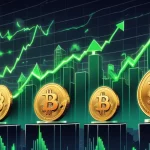XRP 2025 Outlook: AI Predicts Resistance Test as Legal Wins and ETF Hopes Fuel Surge

XRP Price Analysis 2025: AI Signals Resistance Test Amid Legal Triumphs and ETF Hopes
XRP, the native token of Ripple’s payment ecosystem, is at a crossroads that could redefine its place in the crypto hierarchy. With an AI-driven forecast spotlighting a critical resistance test, a game-changing legal victory over the SEC, and near-certain odds of an ETF launch in 2025, the stars might be aligning for this blockchain payments contender. Yet, in a market notorious for volatility and broken promises, can XRP truly deliver, or are we just riding another wave of hype?
- Price Snapshot: XRP at $2.1899, battling resistance between $2.2073–$2.2253.
- Legal Breakthrough: SEC lawsuit resolution removes a major hurdle for institutional adoption.
- ETF Momentum: Bloomberg analysts peg a 95% chance of XRP ETF approval by late 2025.
Legal Clarity: A Turning Point for XRP
The biggest catalyst propelling XRP into the spotlight is the long-awaited resolution of Ripple’s four-year battle with the U.S. Securities and Exchange Commission (SEC). Initiated around 2020, the lawsuit accused Ripple of selling XRP as an unregistered security, casting a shadow over its legitimacy and stifling institutional interest. A pivotal 2023 ruling determined that programmatic sales of XRP—those conducted on exchanges—did not constitute securities, a partial victory that shifted the narrative. With Ripple recently dropping its appeal as of 2025, the regulatory fog has largely lifted, signaling to big players that it’s safer to dive in. Ripple CEO Brad Garlinghouse summed up the shift with confidence:
“Institutional recognition for XRP has already begun.”
This isn’t just a win for Ripple; it’s a potential floodgate for capital. The clarity has already sparked a 101.52% surge in 24-hour trading volume to $4.5 billion as of recent data, pushing XRP’s market cap to $129.29 billion (with a fully diluted valuation of $217.67 billion based on a max supply of 100 billion tokens). For perspective, that volume—equivalent to 86.63 million XRP changing hands daily—dwarfs many altcoins and rivals peaks seen during major Bitcoin rallies, hinting at serious institutional positioning rather than mere retail FOMO. With 59.01 billion tokens in circulation (59% of the total), the market’s appetite suggests XRP is no longer the pariah it once was. For more background on the legal battle, check out the detailed history of Ripple and the SEC lawsuit.
But let’s not get carried away. While the retail sales ruling is a green light, gray areas around institutional sales persist. The SEC could still scrutinize how Ripple handles its massive escrow holdings—over 40% of the supply is controlled by the company, a centralization red flag for purists who champion Bitcoin’s trustless scarcity. If regulators tighten the screws again, today’s optimism could sour fast. The latest updates on the SEC resolution highlight the potential impact on institutional adoption.
ETF Hype: A Gateway to Traditional Finance
Adding to the momentum is the near-certain prospect of an XRP Exchange-Traded Fund (ETF) hitting the market by late 2025. Bloomberg analysts Eric Balchunas and James Seyffart have upgraded the odds to a striking 95%, with some projecting approvals as early as October 2025. For the uninitiated, an ETF is a financial product that tracks an asset’s price, letting investors—think Wall Street funds and pension managers—bet on XRP without directly owning it. It’s like opening a door for traditional finance to pour billions into crypto without navigating the Wild West of exchanges. Ten asset managers, including Grayscale, are already prepping applications, echoing the frenzy that followed Bitcoin and Ethereum ETF launches, which saw inflows of over $10 billion combined in their first year. Learn more about the likelihood of XRP ETF approval from recent analyst reports.
If approved, an XRP ETF could be a tidal wave, potentially driving prices to the $2.80–$3.20 range under bullish scenarios, as forecasted by some models. But here’s the flip side: ETFs might centralize exposure to XRP in the hands of old-school finance, clashing with the decentralization ethos we hold dear. Plus, if approvals stall—say, due to lingering SEC concerns over Ripple’s token distribution—the hype could deflate faster than a popped balloon. And let’s not forget, the crypto market doesn’t exist in a vacuum. If broader altcoin ETFs for Solana or Litecoin launch simultaneously, XRP’s slice of the institutional pie might shrink. Community discussions on platforms like Quora explore the potential implications of such ETF approvals.
Historical Context: XRP’s Rollercoaster Ride
To understand XRP’s current moment, a quick look back is crucial. The token hit an all-time high above $3.40 in January 2018, fueled by crypto mania, only to crash and languish under regulatory uncertainty for years. Even its 2025 peak above $3.10 feels distant, with the current price of $2.1899 sitting 30% below that mark and 43% under the 2018 record. The SEC lawsuit was a millstone, dragging sentiment and adoption down until the recent breakthrough. For newcomers, this history underscores XRP’s speculative volatility—it’s not a steady store of value like Bitcoin aspires to be—but also highlights how legal clarity could mark a new chapter, assuming Ripple plays its cards right. The recent legal victory’s impact on the broader market is worth noting.
Technical Breakdown: Resistance Looms Large
Now, let’s zoom into the price action. As of the latest snapshot, XRP trades at $2.1899, down 2.07% from a daily open of $2.2362, with a 24-hour range between $2.1754 and $2.2537. The critical zone to watch is the resistance band of $2.2073 to $2.2253, aligning with key trend lines like the 50-day and 100-day Exponential Moving Averages (EMAs). For clarity, EMAs smooth out price fluctuations over set periods, weighting recent data more heavily—think of them as a compass for spotting bullish or bearish shifts. XRP sits just above the 20-day EMA of $2.1777 but below the 50-day ($2.2073) and 100-day ($2.2253), with longer-term support at the 200-day EMA of $2.1026 and a psychological floor around $2.00–$2.05.
Other signals are a mixed bag. The Relative Strength Index (RSI) at 50.38 is dead neutral—neither overbought nor oversold, like a market stuck at a crossroads. The Moving Average Convergence Divergence (MACD), a momentum gauge, shows a faint bullish tilt with its line at 0.0128, but a negative histogram of -0.0215 warns that upward steam could stall. ChatGPT o3’s AI model, crunching 42 live indicators, floats three 90-day scenarios: a 45% chance of a breakout to $2.80–$3.20, a 35% likelihood of consolidation between $2.10–$2.25, and a 20% risk of a drop to $1.80–$2.00. Let’s be real, though—AI forecasts are just fancy math, not a crystal ball. Don’t bet your savings on a chatbot’s hunch. For deeper insights into these predictions, explore the AI-driven XRP price forecast analysis. The real test is whether XRP can smash through that resistance wall. If it does, bulls might charge; if not, we’re likely staring at a retreat to test lower supports. Community speculation on Reddit about 2025 price trends and ETF hopes also reflects varied opinions.
Utility in Focus: XRP’s Real-World Edge
Beyond charts and hype, XRP’s value proposition lies in its utility. Built on the XRP Ledger (XRPL), it powers RippleNet, a global payment network that’s gaining traction in regions like Asia-Pacific and Europe. XRP enables cross-border transactions in 3-5 seconds for less than $0.01 each, with XRPL handling over 1,500 transactions per second. Compare that to SWIFT, the traditional banking system, which can take days and charge fees upwards of $20 per transfer, and you see why over 300 financial institutions have partnered with Ripple. Recent expansions include remittance corridors in Latin America and CBDC interoperability pilots with central banks, positioning XRP as a backbone for next-gen finance. A detailed comparison of XRP’s utility versus SWIFT sheds light on its competitive edge.
Moreover, XRPL’s innovations—like the EVM sidechain launch for Ethereum-compatible smart contracts—broaden its appeal beyond mere payments. This isn’t just speculative fluff; it’s infrastructure that could disrupt bloated, slow systems, aligning with our push for effective accelerationism in tech. Yet, XRP isn’t alone in this race. Stellar Lumens targets similar payment niches with a more decentralized setup, and centralized CBDCs could outmuscle both if governments prioritize control over innovation. XRP’s edge hinges on Ripple’s ability to scale partnerships—think specific banks like Santander or SBI Holdings—and prove its tech in real transaction volumes, not just press releases. For updates on Ripple’s growth, see the latest on RippleNet’s expansion across Asia-Pacific and Europe.
Risks and Roadblocks: Don’t Ignore the Fine Print
Before we get too bullish, let’s ground ourselves. XRP’s history of volatility is a glaring warning—it’s not immune to 50% drawdowns, especially if Bitcoin enters a bear market or macro factors like rising interest rates spook risk assets. Regulatory risks haven’t vanished entirely; the SEC could still target Ripple’s institutional sales or escrow practices, even post-resolution. ETF delays are another wildcard—while 95% odds sound great, a single policy shift could derail timelines. And in a crowded altcoin ETF landscape, XRP might not grab the lion’s share of inflows if Solana or others steal the spotlight.
Then there’s the centralization critique. Unlike Bitcoin, where no entity controls the supply, Ripple holds a hefty chunk of XRP, raising trust issues for decentralization diehards. If Ripple missteps—say, by flooding the market with escrowed tokens—investor confidence could crater. Social sentiment, while glowing at 86% positive per LunarCrush (with an AltRank of 213 and a 2.1:1 bullish-to-bearish comment ratio), is notoriously fickle in crypto. Today’s hype can be tomorrow’s dump. XRP’s path to $3.20 is plausible, but a slide to $1.80 isn’t out of the question if the winds shift.
What’s Next for XRP?
Looking ahead, several catalysts could shape XRP’s 2025 trajectory. New RippleNet deals, especially in untapped markets, could cement its utility narrative. XRPL upgrades, like broader EVM adoption, might draw developer interest, while shifts in SEC leadership under future administrations could ease or tighten scrutiny. Community sentiment, currently at a 17-day high, will also play a role—though in crypto, crowd euphoria often precedes a reality check. XRP’s story embodies the broader fight for financial freedom, challenging outdated systems even if its centralized structure doesn’t fully match Bitcoin’s purity. Whether it’s a speculative bubble or a genuine disruptor, one thing is clear: XRP has skin in the game, and in a sea of scam tokens, that’s no small feat.
Key Questions and Takeaways on XRP’s 2025 Outlook
- What’s powering XRP’s market surge in 2025?
A landmark SEC lawsuit resolution, a 95% likelihood of ETF approval by late 2025, and a 101% trading volume jump to $4.5 billion are driving institutional and community excitement. - Do technical indicators signal a clear path for XRP?
Not really—RSI is neutral at 50.38, MACD offers weak bullish hints, and resistance between $2.20–$2.23 is the key hurdle. Breaking it could ignite a rally; stalling might mean a pullback. - Why is an XRP ETF such a game-changer?
With 95% approval odds, an ETF could channel billions from traditional finance into XRP, mirroring Bitcoin’s ETF-driven boom, and potentially reshape altcoin adoption dynamics. - What threats could derail XRP’s momentum?
Lingering regulatory risks on institutional sales, market-wide downturns, or ETF delays could drive prices down to $1.80–$2.00, despite strong tailwinds. - How does XRP’s utility set it apart in crypto?
Powering RippleNet, XRP delivers near-instant, penny-cheap cross-border payments, challenging slow systems like SWIFT and fueling real demand beyond speculative hype. - Is XRP truly aligned with decentralization ideals?
While it disrupts financial inefficiencies, Ripple’s control over much of the supply raises trust concerns compared to Bitcoin’s pure decentralization, even as its utility shines.



